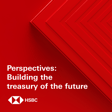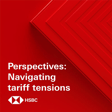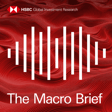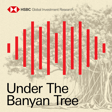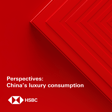Become a Creator today!Start creating today - Share your story with the world!
Start for free
00:00:00
00:00:01

Under the Banyan Tree - India: What's growing, what's not?
Herald van der Linde and Fred Neumann are joined by Chief India Economist Pranjul Bhandari to discuss her latest deep dive into the state of growth across the Indian economy. Disclaimer: https://www.research.hsbc.com/R/101/FvjHlKS. Stay connected and access free to view reports and videos from HSBC Global Research follow us on LinkedIn https://www.linkedin.com/feed/hashtag/hsbcresearch/ or click here: https://www.gbm.hsbc.com/insights/global-research.
Hosted on Acast. See acast.com/privacy for more information.
Transcript
Introduction to HSBC Global Viewpoint
00:00:02
Speaker
Welcome to HSBC Global Viewpoint, the podcast series that brings together business leaders and industry experts to explore the latest global insights, trends, and opportunities.
00:00:13
Speaker
Make sure you're subscribed to stay up to date with new episodes.
00:00:16
Speaker
Thanks for listening.
00:00:17
Speaker
And now onto today's show.
Availability and Disclaimers
00:00:24
Speaker
This is a podcast from HSBC Global Research, available on Apple Podcasts and Spotify.
00:00:29
Speaker
However you're listening, analyst notifications, disclosures and disclaimers must be viewed on the link attached to your media player.
India's Economic Growth Overview
00:00:46
Speaker
Hello from Hong Kong and welcome to Under the Banyan Tree where we put Asian markets and economics in context.
00:00:52
Speaker
I am Harold van der Linde, Head of Asian Equity Strategy at HSBC.
00:00:57
Speaker
And I'm Fred Newman, Chief Asia Economist.
00:00:59
Speaker
Today we're taking the pulse of growth in India, one of Asia's most rapidly growing economies.
00:01:04
Speaker
Our Chief India Economist, Pranjal Bhandari, has gone in-depth looking at 100 key growth indicators and mapping them to various sectors.
00:01:14
Speaker
Pranjul is our guest today on the show, and we're excited to hear about her findings.
00:01:19
Speaker
From HSBC Global Research, you're listening to Under the Banyan Tree.
Decoding India's GDP Performance
00:01:34
Speaker
A little context on India before we start.
00:01:36
Speaker
We've seen very impressive GDP growth upwards of 7% in recent times and have also, of course, been very healthy gains in the equity market over the years.
00:01:46
Speaker
But things look like they're starting to cool a little and a lot of data points are giving us really a bit of a mixed message on the growth picture.
00:01:54
Speaker
On that note, Harold, let's bring in Pranjal for a clean read on the Indian economy.
00:01:59
Speaker
Well, Pranjul, thanks very much for coming on to the podcast.
00:02:03
Speaker
And I know you've crunched an enormous amount of data that give you kind of an idea what is going on with growth in India.
00:02:12
Speaker
We're going to dive into this a little bit, but can you give me just a first broad outline?
00:02:17
Speaker
What is the conclusions that you broadly have drawn?
00:02:21
Speaker
Yeah, thanks, Harold.
00:02:22
Speaker
So lots of questions these days on what's really going on in India.
00:02:26
Speaker
Is growth slowing?
00:02:27
Speaker
Is it going faster than before?
00:02:29
Speaker
Because we just have so much of data.
00:02:31
Speaker
All of them give us mixed messages.
00:02:33
Speaker
So we bought together 100 data points.
00:02:35
Speaker
And what we find
Sectoral Slowdowns
00:02:37
Speaker
is something very specific, which is that about 55% of the economy continues to grow at a positive clip, doing better than it was a quarter ago.
00:02:48
Speaker
which then means that 45% of the economy is not doing as well as it was doing a quarter ago.
00:02:54
Speaker
All of this is interesting because just a quarter back, 65% of the economy was doing very well.
00:03:01
Speaker
So this fall from 65 to 55 is something that's perhaps spooking markets a little bit.
00:03:07
Speaker
So on that note, Pranjul, let's dive a little bit deeper.
00:03:11
Speaker
Where do we see signs of slowing in India?
00:03:15
Speaker
Yeah, a couple of them.
00:03:15
Speaker
So look, I would say one is mining and utilities.
00:03:19
Speaker
It's very interesting that we had some adverse weather events a quarter ago.
00:03:24
Speaker
We had heat waves.
00:03:25
Speaker
Peak demand for power was very strong, but the weather has normalized.
00:03:29
Speaker
The peak demand is not there.
00:03:30
Speaker
So all of this mining and utility growth has actually fallen.
00:03:34
Speaker
So that's one part.
00:03:35
Speaker
But I think what's bigger than this is what's going on in consumer demand, that both in urban India and in rural India, consumer demand is coming off a little bit.
Positive Economic Drivers
00:03:45
Speaker
And in fact, one indicator that we like to look at is the GST collections, the tax collections, which has a little part in it called CES, which is the money you get from high luxury items.
00:03:55
Speaker
That is what was really driving the GST growth.
00:03:58
Speaker
And that is the part that has slowed the most.
00:04:00
Speaker
So we're seeing a lot of the high end consumption, the luxury consumption actually coming off.
00:04:05
Speaker
Yeah, I'm wondering, Pranju, but we probably don't have any data on this, but the stock market in India has done just phenomenally well over the last couple of years.
00:04:12
Speaker
So a lot of people who would have played in the stock market have made some nice gains.
00:04:18
Speaker
I wonder in how far that then goes into luxury spending, if there's a bit of a wealth effect in India, or do you think that's too small still?
00:04:25
Speaker
Most people don't have enough exposure to equities.
00:04:28
Speaker
Well, look, you know, there was something which was like keeping consumption growth high.
00:04:31
Speaker
I think it was the combination of high credit growth, you know, high incomes in high tech sectors, and also, you know, wealth effects from very strong equity markets.
00:04:42
Speaker
And my sense is that all three parts have softened a little bit and that's something that's going to play and show up in the markets.
00:04:48
Speaker
And what about the positives, Pranjal?
00:04:50
Speaker
Where are we still seeing solid growth in India?
00:04:53
Speaker
Yeah, so there are actually three of them.
00:04:55
Speaker
One is agriculture, because the heatwaves are behind us.
00:04:58
Speaker
Agricultural growth has picked up.
00:05:00
Speaker
And my hope is that over time, we can start seeing that in rural demand.
00:05:05
Speaker
And then there's government spending, because we had elections earlier this year.
00:05:08
Speaker
They had slowed for some time, but they've picked up.
00:05:12
Speaker
In fact, both the central and state governments are doing a lot of capital expenditure, CapEx push as well.
00:05:17
Speaker
So we're seeing investment data, construction data as pretty strong.
00:05:22
Speaker
led to a large extent by government spending having picked up.
00:05:26
Speaker
And then there's exports, which I actually like the most because it's really a story of how the export basket has diversified in India.
00:05:33
Speaker
It's not just your goods exports.
00:05:34
Speaker
The October services trade surplus was the highest ever.
00:05:38
Speaker
These are the parts of the economy that are still doing very well.
FDI Trends in India
00:05:42
Speaker
Just as a side question, there's been a lot of talk about investments and FDI coming into India.
00:05:48
Speaker
People want to reduce their reliance on, say, North Asia and mainland China.
00:05:54
Speaker
Is that a growth driver?
00:05:55
Speaker
Do we see massive FDI coming in?
00:05:57
Speaker
Or is that something we talk about and that just has to materialize yet?
00:06:02
Speaker
Or are they maybe already exporting?
00:06:03
Speaker
I don't know.
00:06:04
Speaker
Yeah, I think it's a little bit of the latter.
00:06:06
Speaker
You know, we see a very strong investment intentions out there.
00:06:09
Speaker
So people really want to come in India, particularly in high tech sectors, semiconductors, data centers, artificial intelligence, EV, solar panels.
00:06:20
Speaker
But when we look at the actual FDI numbers, it has been a tad disappointing.
00:06:24
Speaker
I don't think it's just India.
00:06:25
Speaker
I think when I look around the emerging markets, I think FDI inflows have slowed over the last year.
00:06:31
Speaker
Yeah, no,
Growth Normalization in India
00:06:32
Speaker
that's correct.
00:06:32
Speaker
So broadly speaking, sales for the air conditioning is slowing down a little bit.
00:06:37
Speaker
I'm making it very simplistic and luxury sales a bit as well.
00:06:41
Speaker
On the other hand, the government is spending a little bit more.
00:06:44
Speaker
Rural agriculture is doing a little bit better.
00:06:46
Speaker
That offsets that.
00:06:47
Speaker
So that's good.
00:06:48
Speaker
So what does this all mean for you as an economist if you look into 2025 and beyond?
00:06:53
Speaker
Yeah.
00:06:53
Speaker
So look, you know, my sense is that the strong growth we've seen in India for the last couple of years has come on the back of what I call new India.
00:07:01
Speaker
Lots of high tech sectors, you know, electronics, manufacturing, services, exports, digital public infrastructure on the back of which we've seen so many startups sprout in the economy.
00:07:13
Speaker
But my sense is that after a couple of years of very strong growth, it's normalizing a little bit.
00:07:19
Speaker
The base is also becoming high.
00:07:21
Speaker
It's hard to grow 30% year on year, you know, every single year, you know, what we've seen in professional services exports.
00:07:28
Speaker
What does this mean for growth?
00:07:29
Speaker
My sense is that, you know, growth is coming down from about 7% to around 6.5%.
00:07:35
Speaker
And this is that normalization, which I think is spooking a lot of people.
00:07:39
Speaker
But the six and a half percent number is still a very strong number.
00:07:42
Speaker
And if it comes on the back of agriculture, rural demand picking up, then it could actually mean growth becomes more broad based than it was in the last two years when it was quite concentrated on luxury goods and top of the pyramid.
00:07:55
Speaker
So I think I would call this more a normalization rather than a slowdown.
00:07:59
Speaker
Yeah, normalization sounds good in the sense that if you have very high growth, all sorts of excesses can build up, like inflation and these sort of things.
00:08:08
Speaker
And you want to avoid that as well, I guess.
00:08:10
Speaker
So that's a good
Market Implications and Conclusion
00:08:12
Speaker
thing.
00:08:12
Speaker
Now, I'd like to take a break now and come back after the break and see what this really means for markets and people that invest in India as well.
00:08:30
Speaker
So we're back with Pranjal Bhandari talking about growth in India.
00:08:34
Speaker
And I think the takeaway from part one was really that the picture is starting to normalize in the economy.
00:08:40
Speaker
Now, Pranjal, I know Harold is desperate to steer the conversation into equities as always.
00:08:45
Speaker
But before we let him do that, I want to ask you a quick question on the currency.
00:08:49
Speaker
When we look at the rupee, it's actually been trading quite a lot lower in recent weeks.
00:08:54
Speaker
It is quite a bit weaker in
00:08:56
Speaker
Is that just because of normalization that we're seeing or is there something else to it?
00:09:01
Speaker
Well, I think it's the external, it's the global backdrop, US elections, the dollar has been strong.
00:09:07
Speaker
We've also seen outflows from India's equity markets, 12 to $13 billion over the last two months.
00:09:14
Speaker
So I think all of that has weighed on the rupee.
00:09:16
Speaker
I think all of this has implications for monetary policy.
00:09:20
Speaker
You know, about a month ago, there were expectations that they may cut rates.
00:09:23
Speaker
But my sense is they'll find it hard to cut rates at a time when
00:09:27
Speaker
the exchange rate is volatile and at a time when inflation is pretty high.
00:09:32
Speaker
In fact, the latest inflation number showed that inflation is 6% plus, which is higher than where RBI would like it to be.
00:09:41
Speaker
A lot of it is because of food prices.
00:09:43
Speaker
And once food prices begin to fall, they actually fall very quickly, particularly vegetable prices.
00:09:48
Speaker
But until we don't see that happen, our sense is the RBI will not be cutting rates.
00:09:53
Speaker
So we expect no rate cuts in 2024.
00:09:56
Speaker
Hopefully in early 2025, we'll see one to two rate cuts.
00:10:00
Speaker
So Harold, you know, everybody's noticing that equity markets have begun to weaken a little bit in India.
00:10:06
Speaker
What's going on there?
00:10:08
Speaker
Well, Pranju, I think it was really interesting to listen to what you've been saying, because I think there's a couple of things that have impacted the equity market that are directly linked to what you said.
00:10:17
Speaker
But there's a couple of other things going on as well.
00:10:19
Speaker
So let me put this point wise together.
00:10:22
Speaker
You mentioned about moderation in growth.
00:10:25
Speaker
We've seen this in the equity market as well.
00:10:27
Speaker
Since the summer, the expectation was that, hey, maybe the high growth era is over.
00:10:32
Speaker
We're seeing a moderation in earnings growth as well.
00:10:35
Speaker
It's earnings growth, not economic growth.
00:10:36
Speaker
That's so important for equities.
00:10:38
Speaker
And that was not always driven by what you mentioned, but more by, for example, that the banks really had to compete to get the deposits in because everybody was taking money out and putting it into the stock market.
00:10:49
Speaker
So they raised their rates sometimes a little bit to make sure people wanted to keep the deposits in and that's bad for their margins.
00:10:56
Speaker
But some of the consumer stuff that you talked about, we've seen that also in the consumer sector coming through.
00:11:01
Speaker
So we see a moderation in growth, probably somewhat in line to what you talked about this as well.
00:11:08
Speaker
But there are also other factors.
00:11:10
Speaker
We see a stronger dollar.
00:11:11
Speaker
We see that interest in China has come back.
00:11:14
Speaker
So people have taken money out of India, it seems, and then said, OK, let's put this in China at work.
00:11:20
Speaker
I could book some nice profits in India and hopefully I can make some more profits of it in China.
00:11:25
Speaker
So there's a sort of rotation within the region going on as well.
00:11:29
Speaker
How far can this rotation continue?
00:11:31
Speaker
Actually, if we look at the funds, a lot of the Asian specialists, they've already made a large part of this sort of rotation.
00:11:40
Speaker
A lot of the global funds have not done so.
00:11:43
Speaker
So it could well be that we're already well into some sort of rotation in Asian equities.
00:11:50
Speaker
And this maybe can continue a little bit longer, but we're already moving into the second half of this game, if you want to put it like this.
00:11:57
Speaker
So keeping that all in mind, it was really interesting to read your report, Pranjo, with all the data that you've gone through over the last couple of weeks.
00:12:05
Speaker
It must have been a big job.
00:12:08
Speaker
Hopefully, we can invite you back soon on another podcast just to see what the update is.
00:12:13
Speaker
And as we go into 2025, if the growth is really moderating or if it's hanging a little bit higher or if it's actually slowing even further than what we anticipate at the moment.
00:12:22
Speaker
But for now, thanks for coming on to the podcast.
00:12:26
Speaker
And that's what we've got to sign off for another week, folks.
00:12:29
Speaker
Many thanks for joining us.
00:12:30
Speaker
And remember, if you're an HSBC client, the polls are now open in the 2025 Asia Extel vote.
00:12:37
Speaker
Please do keep HSBC Global Research in mind when you're voting.
00:12:41
Speaker
In the meantime, give our sister podcast a macro brief and listen for our latest global economic views available wherever you get your podcasts.
00:12:48
Speaker
Take care and we'll talk to you again soon.
00:13:23
Speaker
Thank you for joining us at HSBC Global Viewpoint.
00:13:26
Speaker
We hope you enjoyed the discussion.
00:13:28
Speaker
Make sure you're subscribed to stay up to date with new episodes.
